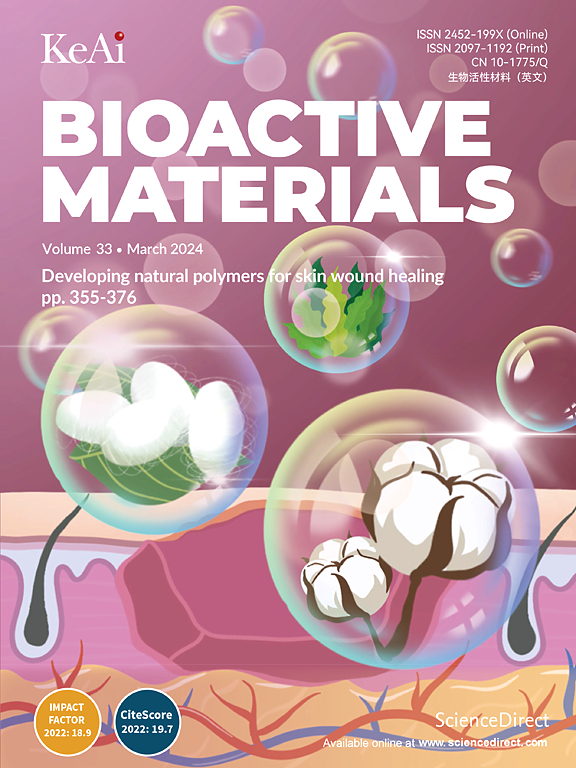A charge reversal nano-assembly prevents hepatic steatosis by resolving inflammation and improving lipid metabolism
IF 18
1区 医学
Q1 ENGINEERING, BIOMEDICAL
引用次数: 0
Abstract
Lipid metabolism imbalance combined with over-activated inflammation are two key factors for hepatic stestosis. However, on-demand anchoring inflammation and lipid metabolism disorder for hepatic stestosis treatment has yet to be realized. Here we propose a charge reversal fullerene based nano-assembly to migrate hepatic steatosis via inhibiting macrophage-mediated inflammation and normalizing hepatocellular lipid metabolism in obesity mice. Our nano-assembly (abbreviated as FPPD) is comprised of electropositive polyetherimide (PEI), charge-shielded dimethylmaleic anhydride (DMA), and poly(lactic-co-glycolic acid) (PLGA), which provides hydrophobic chains for self-assembly with anti-oxidative dicarboxy fullerene poly(ethylene glycol) molecule (FP). The obtained FPPD nano-assembly owns a charge reversal ability that switches to a positive charge in an acidic environment that targets the electronegative mitochondria both in pro-inflammatory macrophages and steatosis hepatocytes. We demonstrate that the anti-oxidative and mitochondria-targeting FPPD notably reduces inflammation in macrophages and lipid accumulation in hepatocytes by quenching excessive reactive oxygen species (ROS) and improving mitochondrial function in vitro. Importantly, FPPD nano-assembly reveals a superior anti-hepatic steatosis effect via migrating inflammation and facilitating lipid transport in obesity mice. Overall, the charge reversal nano-assembly reduces over-activated inflammation and promotes lipid metabolism that provides an effectiveness of a multi-target strategy for hepatic steatosis treatment.

电荷反转纳米组件防止肝脏脂肪变性通过解决炎症和改善脂质代谢。
脂质代谢失衡与炎症过度激活是肝内脂肪肝的两个关键因素。然而,按需锚定炎症和脂质代谢紊乱治疗肝脂肪肝尚未实现。在此,我们提出了一种基于电荷反转富勒烯的纳米组装,通过抑制巨噬细胞介导的炎症和使肥胖小鼠的肝细胞脂质代谢正常化来迁移肝脏脂肪变性。我们的纳米组件(简称FPPD)由正电聚醚酰亚胺(PEI)、带电荷屏蔽的二甲基马来酸酐(DMA)和聚乳酸-羟基乙酸(PLGA)组成,PLGA提供疏水链,用于与抗氧化的二羧基富勒烯聚乙二醇分子(FP)自组装。获得的FPPD纳米组件具有电荷逆转能力,可在酸性环境中转换为正电荷,针对促炎巨噬细胞和脂肪变性肝细胞中的电负性线粒体。我们证明了抗氧化和靶向线粒体的FPPD通过猝灭过多的活性氧(ROS)和改善线粒体功能,显著减少巨噬细胞的炎症和肝细胞的脂质积累。重要的是,FPPD纳米组件揭示了通过迁移炎症和促进脂肪转运在肥胖小鼠中具有优越的抗肝脂肪变性作用。总的来说,电荷逆转纳米组件减少了过度激活的炎症,促进了脂质代谢,为肝脂肪变性治疗提供了多靶点策略的有效性。
本文章由计算机程序翻译,如有差异,请以英文原文为准。
求助全文
约1分钟内获得全文
求助全文
来源期刊

Bioactive Materials
Biochemistry, Genetics and Molecular Biology-Biotechnology
CiteScore
28.00
自引率
6.30%
发文量
436
审稿时长
20 days
期刊介绍:
Bioactive Materials is a peer-reviewed research publication that focuses on advancements in bioactive materials. The journal accepts research papers, reviews, and rapid communications in the field of next-generation biomaterials that interact with cells, tissues, and organs in various living organisms.
The primary goal of Bioactive Materials is to promote the science and engineering of biomaterials that exhibit adaptiveness to the biological environment. These materials are specifically designed to stimulate or direct appropriate cell and tissue responses or regulate interactions with microorganisms.
The journal covers a wide range of bioactive materials, including those that are engineered or designed in terms of their physical form (e.g. particulate, fiber), topology (e.g. porosity, surface roughness), or dimensions (ranging from macro to nano-scales). Contributions are sought from the following categories of bioactive materials:
Bioactive metals and alloys
Bioactive inorganics: ceramics, glasses, and carbon-based materials
Bioactive polymers and gels
Bioactive materials derived from natural sources
Bioactive composites
These materials find applications in human and veterinary medicine, such as implants, tissue engineering scaffolds, cell/drug/gene carriers, as well as imaging and sensing devices.
 求助内容:
求助内容: 应助结果提醒方式:
应助结果提醒方式:


